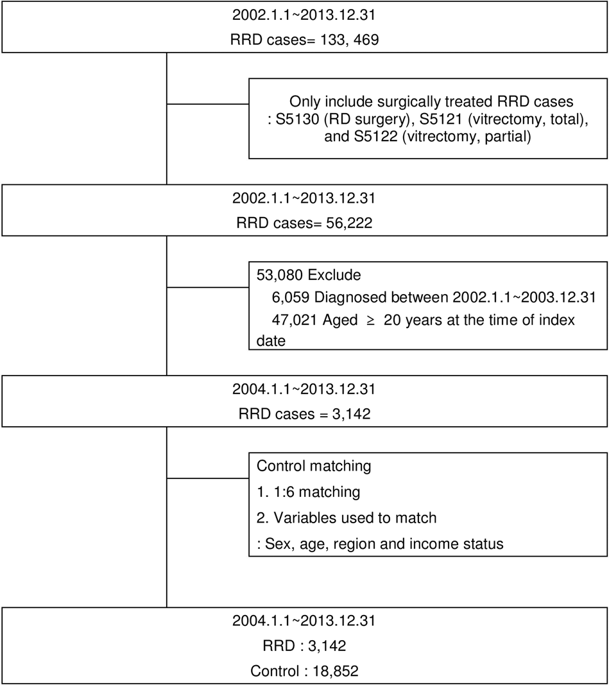Our official English website, www.x-mol.net, welcomes your
feedback! (Note: you will need to create a separate account there.)
The Association with rhegmatogenous retinal detachment and paediatric atopic dermatitis: a 12-year Nationwide Cohort Study
Eye ( IF 2.8 ) Pub Date : 2020-02-20 , DOI: 10.1038/s41433-020-0816-1 M Choi 1 , S J Byun 2 , D H Lee 3 , K H Kim 3 , K H Park 2 , S J Park 2
Eye ( IF 2.8 ) Pub Date : 2020-02-20 , DOI: 10.1038/s41433-020-0816-1 M Choi 1 , S J Byun 2 , D H Lee 3 , K H Kim 3 , K H Park 2 , S J Park 2
Affiliation

|
Purpose Historically, atopic dermatitis (AD) is associated with an increased risk of rhegmatogenous retinal detachment (RRD). However, uncertainty remained regarding the effect of AD itself and comorbidities (e.g., allergic diseases, cataract surgery) on RRD occurrence in a large, population-based paediatric population. Patients and methods We analysed the 12-year National Health Insurance Service database (2002–2013) covering the entire Korean population to estimate the association between AD and RRD in people aged under 20 years. Results We identified 3142 RRD patients, and matched 18,852 controls (six controls to each RRD patient); therefore, we included 21,994 peoples under aged 20 years in the analyses. AD was more prevalent in the RRD group (329 patients, 10.47%) than the control group (1043 patients, 5.53%; P < 0.001), and so were severe AD (153 patients [4.87%] and 223 patients [1.18%], respectively; P < 0.001). In conditional logistic regression analysis, AD was associated with RRD (OR, 1.61; 95% CI, 1.93–1.87) even after adjusting for allergic conditions, connective tissue disease, uveitis, and cataract surgery. In addition, severity of AD was associated with an increased risk of RRD (OR for non-severe AD and severe AD, 1.26 [95% CI, 1.05–1.51] and 2.88 [95% CI, 2.25–3.68]). Conclusion This study suggests that AD itself is a risk factor of RRD in children by showing the association between AD and RRD occurrence and the biologic gradient even after adjustment for known confounders including allergic conditions, uveitis, and cataract surgery.
中文翻译:

与孔源性视网膜脱离和小儿特应性皮炎的关联:一项为期 12 年的全国队列研究
目的 从历史上看,特应性皮炎 (AD) 与孔源性视网膜脱离 (RRD) 的风险增加有关。然而,AD 本身和合并症(例如,过敏性疾病、白内障手术)对大量基于人群的儿科人群中 RRD 发生的影响仍存在不确定性。患者和方法 我们分析了涵盖整个韩国人口的 12 年国民健康保险服务数据库(2002-2013 年),以估计 20 岁以下人群 AD 与 RRD 之间的关联。结果 我们确定了 3142 名 RRD 患者,并匹配了 18,852 名对照(每个 RRD 患者有 6 个对照);因此,我们在分析中纳入了 21,994 名 20 岁以下的人。RRD 组(329 例患者,10.47%)的 AD 比对照组(1043 例患者,5.53%;P < 0.001)更普遍,重度 AD 也是如此(分别为 153 名患者 [4.87%] 和 223 名患者 [1.18%];P < 0.001)。在条件逻辑回归分析中,即使在调整过敏条件、结缔组织病、葡萄膜炎和白内障手术后,AD 与 RRD 相关(OR,1.61;95% CI,1.93-1.87)。此外,AD 的严重程度与 RRD 风险增加相关(对于非重度 AD 和重度 AD,OR 分别为 1.26 [95% CI, 1.05–1.51] 和 2.88 [95% CI, 2.25–3.68])。结论这项研究表明,即使在调整了已知的混杂因素(包括过敏状况、葡萄膜炎和白内障手术)后,AD 本身也是儿童 RRD 的危险因素,它显示了 AD 和 RRD 的发生与生物梯度之间的关联。在条件逻辑回归分析中,即使在调整过敏条件、结缔组织病、葡萄膜炎和白内障手术后,AD 与 RRD 相关(OR,1.61;95% CI,1.93-1.87)。此外,AD 的严重程度与 RRD 风险增加相关(对于非重度 AD 和重度 AD,OR 分别为 1.26 [95% CI, 1.05–1.51] 和 2.88 [95% CI, 2.25–3.68])。结论这项研究表明,即使在调整了已知的混杂因素(包括过敏状况、葡萄膜炎和白内障手术)后,AD 本身也是儿童 RRD 的危险因素,它显示了 AD 和 RRD 的发生与生物梯度之间的关联。在条件逻辑回归分析中,即使在调整过敏条件、结缔组织病、葡萄膜炎和白内障手术后,AD 与 RRD 相关(OR,1.61;95% CI,1.93-1.87)。此外,AD 的严重程度与 RRD 风险增加相关(对于非重度 AD 和重度 AD,OR 分别为 1.26 [95% CI, 1.05–1.51] 和 2.88 [95% CI, 2.25–3.68])。结论这项研究表明,即使在调整了已知的混杂因素(包括过敏状况、葡萄膜炎和白内障手术)后,AD 本身也是儿童 RRD 的危险因素,它显示了 AD 和 RRD 的发生与生物梯度之间的关联。AD 的严重程度与 RRD 风险增加相关(非严重 AD 和严重 AD 的 OR 为 1.26 [95% CI, 1.05–1.51] 和 2.88 [95% CI, 2.25–3.68])。结论这项研究表明,即使在调整了已知的混杂因素(包括过敏状况、葡萄膜炎和白内障手术)后,AD 本身也是儿童 RRD 的危险因素,它显示了 AD 和 RRD 的发生与生物梯度之间的关联。AD 的严重程度与 RRD 风险增加相关(非严重 AD 和严重 AD 的 OR 为 1.26 [95% CI, 1.05–1.51] 和 2.88 [95% CI, 2.25–3.68])。结论这项研究表明,即使在调整了已知的混杂因素(包括过敏状况、葡萄膜炎和白内障手术)后,AD 本身也是儿童 RRD 的危险因素,它显示了 AD 和 RRD 的发生与生物梯度之间的关联。
更新日期:2020-02-20
中文翻译:

与孔源性视网膜脱离和小儿特应性皮炎的关联:一项为期 12 年的全国队列研究
目的 从历史上看,特应性皮炎 (AD) 与孔源性视网膜脱离 (RRD) 的风险增加有关。然而,AD 本身和合并症(例如,过敏性疾病、白内障手术)对大量基于人群的儿科人群中 RRD 发生的影响仍存在不确定性。患者和方法 我们分析了涵盖整个韩国人口的 12 年国民健康保险服务数据库(2002-2013 年),以估计 20 岁以下人群 AD 与 RRD 之间的关联。结果 我们确定了 3142 名 RRD 患者,并匹配了 18,852 名对照(每个 RRD 患者有 6 个对照);因此,我们在分析中纳入了 21,994 名 20 岁以下的人。RRD 组(329 例患者,10.47%)的 AD 比对照组(1043 例患者,5.53%;P < 0.001)更普遍,重度 AD 也是如此(分别为 153 名患者 [4.87%] 和 223 名患者 [1.18%];P < 0.001)。在条件逻辑回归分析中,即使在调整过敏条件、结缔组织病、葡萄膜炎和白内障手术后,AD 与 RRD 相关(OR,1.61;95% CI,1.93-1.87)。此外,AD 的严重程度与 RRD 风险增加相关(对于非重度 AD 和重度 AD,OR 分别为 1.26 [95% CI, 1.05–1.51] 和 2.88 [95% CI, 2.25–3.68])。结论这项研究表明,即使在调整了已知的混杂因素(包括过敏状况、葡萄膜炎和白内障手术)后,AD 本身也是儿童 RRD 的危险因素,它显示了 AD 和 RRD 的发生与生物梯度之间的关联。在条件逻辑回归分析中,即使在调整过敏条件、结缔组织病、葡萄膜炎和白内障手术后,AD 与 RRD 相关(OR,1.61;95% CI,1.93-1.87)。此外,AD 的严重程度与 RRD 风险增加相关(对于非重度 AD 和重度 AD,OR 分别为 1.26 [95% CI, 1.05–1.51] 和 2.88 [95% CI, 2.25–3.68])。结论这项研究表明,即使在调整了已知的混杂因素(包括过敏状况、葡萄膜炎和白内障手术)后,AD 本身也是儿童 RRD 的危险因素,它显示了 AD 和 RRD 的发生与生物梯度之间的关联。在条件逻辑回归分析中,即使在调整过敏条件、结缔组织病、葡萄膜炎和白内障手术后,AD 与 RRD 相关(OR,1.61;95% CI,1.93-1.87)。此外,AD 的严重程度与 RRD 风险增加相关(对于非重度 AD 和重度 AD,OR 分别为 1.26 [95% CI, 1.05–1.51] 和 2.88 [95% CI, 2.25–3.68])。结论这项研究表明,即使在调整了已知的混杂因素(包括过敏状况、葡萄膜炎和白内障手术)后,AD 本身也是儿童 RRD 的危险因素,它显示了 AD 和 RRD 的发生与生物梯度之间的关联。AD 的严重程度与 RRD 风险增加相关(非严重 AD 和严重 AD 的 OR 为 1.26 [95% CI, 1.05–1.51] 和 2.88 [95% CI, 2.25–3.68])。结论这项研究表明,即使在调整了已知的混杂因素(包括过敏状况、葡萄膜炎和白内障手术)后,AD 本身也是儿童 RRD 的危险因素,它显示了 AD 和 RRD 的发生与生物梯度之间的关联。AD 的严重程度与 RRD 风险增加相关(非严重 AD 和严重 AD 的 OR 为 1.26 [95% CI, 1.05–1.51] 和 2.88 [95% CI, 2.25–3.68])。结论这项研究表明,即使在调整了已知的混杂因素(包括过敏状况、葡萄膜炎和白内障手术)后,AD 本身也是儿童 RRD 的危险因素,它显示了 AD 和 RRD 的发生与生物梯度之间的关联。











































 京公网安备 11010802027423号
京公网安备 11010802027423号